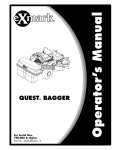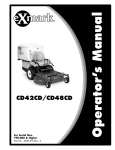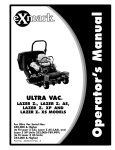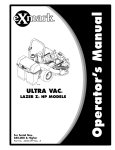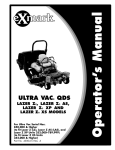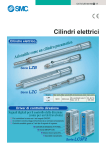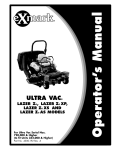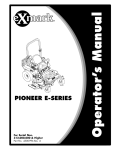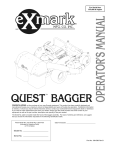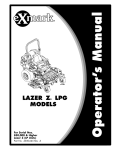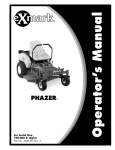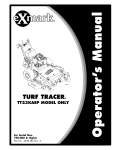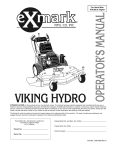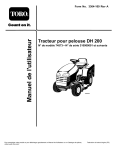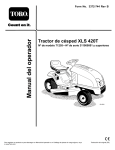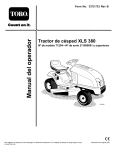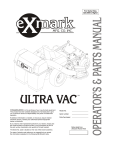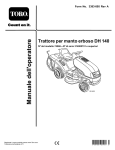Download Exmark Ultra Vac 000 & higher User's Manual
Transcript
ULTRA VAC ® LAZER Z®, LAZER Z® AS SERIES X, AND LAZER Z® AS MODELS For Ultra Vac Serial Nos. 850,000 & Higher (To fit Lazer Z (LZZ) and Lazer Z AS Series X (LZAS) Units Serial Nos. 790,000 & Higher) (To fit Lazer Z AS (LZA) Units Serial Nos. 850,000 & Higher) Part No. 4500-608 Rev. A Exmark reserves the right to make changes or add improvements to its products at any time without incurring any obligation to make such changes to products manufactured previously. Exmark, or its distributors and dealers, accept no responsibility for variations which may be evident in the actual specifications of its products and the statements and descriptions contained in this publication. © 2009—Exmark Mfg. Co., Inc. Industrial Park Box 808 Beatrice, NE 68310 2 Contact us at www.Exmark.com. Printed in the USA All Rights Reserved Introduction CONGRATULATIONS on the purchase of your Exmark Ultra Vac. This product has been carefully designed and manufactured to give you a maximum amount of dependability and years of trouble-free operation. This manual contains operating, maintenance, adjustment, and safety instructions for your Exmark Ultra Vac Figure 1 1. Model and serial number location BEFORE OPERATING YOUR MOWER, CAREFULLY READ THIS MANUAL IN ITS ENTIRETY. Model No. By following the operating, maintenance, and safety instructions, you will prolong the life of your Ultra Vac, maintain its maximum efficiency, and promote safe operation. Serial No. If additional information is needed, or should you require trained mechanic service, contact your authorized Exmark equipment dealer or distributor. Exmark parts manuals are available online at http://www.exmark.com/manuals.htm. All Exmark equipment dealers and distributors are kept informed of the latest methods of servicing and are equipped to provide prompt and efficient service in the field or at their service stations. They carry ample stock of service parts or can secure them promptly for you from the factory. All Exmark parts are thoroughly tested and inspected before leaving the factory, however, attention is required on your part if you are to obtain the fullest measure of satisfaction and performance. Whenever you need service, genuine Exmark parts, or additional information, contact an Authorized Service Dealer or Exmark Customer Service and have the model and serial numbers of your product ready. Figure 1 identifies the location of the model and serial numbers on the product. Write the numbers in the space provided. 3 Contents Introduction ........................................................... 3 Safety ..................................................................... 5 Safety Alert Symbol ......................................... 5 Safe Operating Practices .................................. 5 Safety and Instructional Decals ....................... 8 Specifications ....................................................... 10 Model Numbers ............................................ 10 Systems ......................................................... 10 Dimensions................................................... 10 Torque Requirements .................................... 10 Product Overview ................................................ 11 Operation ............................................................. 11 Pre-Start........................................................ 11 Operating Instructions .................................. 11 Transporting ................................................. 17 Maintenance ......................................................... 20 Recommended Maintenance Schedule(s) ........... 20 Periodic Maintenance ....................................... 20 Check Blower Housing/Impeller ................... 20 Check Bags.................................................... 20 Check Exhaust Diverter................................. 21 Lubricate Grease Fittings............................... 21 Check Condition of Belt ................................ 21 Adjustments ..................................................... 21 Adjusting the Blower Drive Belt Position..................................................... 21 Cleaning ........................................................... 22 Clean Muffler and Rear Frame Area................ 22 Clean Rear Screen In Hopper......................... 22 Clean Blower................................................. 22 Troubleshooting ................................................... 23 4 Safety Safety • Never let children or untrained people operate or service the equipment. Local regulations may restrict the age of the operator. Safety Alert Symbol • Only adults and mature teenagers should operate a mower, and even mature teenagers should have adult supervision. Be sure a teenager: This Safety Alert Symbol (Figure 2) is used both in this manual and on the machine to identify important safety messages which must be followed to avoid accidents 1. has read and understands the Operator’s Manual and recognizes the risks involved; This symbol means: ATTENTION! BECOME ALERT! YOUR SAFETY IS INVOLVED! 2. is sufficiently mature to use caution; and 3. is of sufficient size and weight to operate the controls comfortably and to manage the mower without taking risks. Figure 2 • The owner/user can prevent and is responsible for accidents or injuries occurring to himself or herself, other people or property. 1. Safety alert symbol The safety alert symbol appears above information which alerts you to unsafe actions or situations and will be followed by the word DANGER, WARNING, or CAUTION. Preparation • Evaluate the terrain to determine what accessories and attachments are needed to properly and safely perform the job. Only use on machines approved by Exmark. DANGER: White lettering / Red background. Indicates an imminently hazardous situation which, if not avoided, Will result in death or serious injury. • Wear appropriate clothing including safety glasses, substantial footwear, long trousers, and hearing protection. Do Not operate when barefoot or when wearing open sandals. WARNING: Black lettering / Orange background. Indicates a potentially hazardous situation which, if not avoided, Could result in death or serious injury. CAUTION CAUTION: Black lettering / Yellow background. Indicates a potentially hazardous situation which, if not avoided, May result in minor or moderate injury. This machine produces sound levels in excess of 85 dBA at the operator’s ear and can cause hearing loss through extended periods of exposure. This manual uses two other words to highlight information. Important calls attention to special mechanical information and Note emphasizes general information worthy of special attention. Wear hearing protection when operating this machine. Safe Operating Practices • Inspect the area where the equipment is to be used and remove all rocks, toys, sticks, wires, bones, and other foreign objects which can be thrown by the machine and may cause personal injury to the operator or bystanders. Training • Read the tractor and Ultra Vac Operator’s Manuals and other training material. If the operator(s) or mechanic(s) can not read English it is the owner’s responsibility to explain this material to them. Operation • Become familiar with the safe operation of the equipment, operator controls, and safety signs. • Operate only in daylight or good artificial light, keeping away from holes and hidden hazards. • All operators and mechanics should be trained. The owner is responsible for training the users. • Never mow with the discharge deflector raised, removed or altered unless there is a grass 5 Safety Slope Operation collection system or mulch kit in place and working properly. Use Extreme caution when mowing and/or turning on slopes as loss of traction and/or tip-over could occur. The operator is responsible for safe operation on slopes. DANGER There are rotating blades in the blower and under the mower deck. Blade contact can cause serious operator or bystander injury or even death. DANGER Operating on wet grass or steep slopes can cause sliding and loss of control. Wheels dropping over edges, ditches, steep banks, or water can cause rollovers, which may result in serious injury, death or drowning. • Do Not reach into blower unless rotation indicator has stopped. Disengage PTO, stop engine, remove key, wait for all moving parts to stop. Engage parking brake. • Do Not mow slopes when grass is wet. • Never operate mower unless discharge deflector, entire grass collection system, or mulch kit is installed. • Do Not mow near drop-offs or near water. • Do Not mow slopes greater than 15 degrees. • Stop engine, wait for all moving parts to stop, remove key and engage parking brake: • Reduce speed and use extreme caution on slopes. – Before checking, cleaning or working on the mower. • Avoid sudden turns or rapid speed changes. – After striking a foreign object or abnormal vibration occurs (inspect the mower for damage and make repairs before restarting and operating the mower). • Keep the roll bar in the raised and locked position and use seat belt. • See inside the back cover to determine the approximate slope angle of the area to be mowed. – Before clearing blockages. – Whenever you leave the mower. • Use a walk behind mower and/or a hand trimmer near drop-offs, ditches, steep banks or water. (Figure 3). WARNING Hands, feet, hair, clothing, or accessories can become entangled in rotating parts. Contact with the rotating parts can cause traumatic amputation or severe lacerations. • Do Not operate the machine without guards, shields, and safety devices in place and working properly. • Keep hands, feet, hair, jewelry, or clothing away from rotating parts. • Stop the blades, slow down, and use caution when crossing surfaces other than grass and when transporting the mower to and from the area to be mowed. • Be aware of the mower discharge path and direct discharge away from others. 6 Safety progressively greater care on slopes as the hopper fills. Maintenance and Storage • Disengage PTO, set parking brake, stop engine and remove key or disconnect spark plug wire. Wait for all movement to stop before adjusting, cleaning or repairing. • Use care when checking blades. Wrap the blade(s) or wear gloves, and use caution when servicing them. Only replace damaged blades. Never straighten or weld them. • Keep all guards, shields and all safety devices in place and in safe working condition. Figure 3 1. Safe Zone-Use the mower here on slopes less than 15 degrees 2. Danger Zone-Use a walk behind mower and/or hand trimmer on slopes greater than 15 degrees, near drop-offs and water. 3. Water • Check all bolts frequently to maintain proper tightness. • Frequently check for worn or deteriorating components that could create a hazard. • All replacement parts must be the same as or equivalent to the parts supplied as original equipment. • Remove or mark obstacles such as rocks, tree limbs, etc. from the mowing area. Tall grass can hide obstacles. • Watch for ditches, holes, rocks, dips and rises that change the operating angle, as rough terrain could overturn the machine. • Avoid sudden starts when mowing uphill because the mower may tip backwards. • Be aware that operating on wet grass, across steep slopes or downhill may cause the mower to lose traction. Loss of traction to the drive wheels may result in sliding and a loss of braking and steering. • Always avoid sudden starting or stopping on a slope. If tires lose traction, disengage the blades and proceed slowly off the slope. • Follow the manufacturer’s recommendations for wheel weights or counter weights to improve stability. Always install and remove the Ultra Vac, including counter weights, as instructed. Failure to do so will cause a reduction in stability or traction. Do Not operate the mower with only a portion of the Ultra Vac installed. • Use extreme care with grass catchers or attachments. These can change the stability of the machine and cause loss of control. The stability and traction of the machine will change as the Ultra Vac hopper fills with grass clippings. Use 7 Safety Safety and Instructional Decals • Keep all safety signs legible. Remove all grease, dirt and debris from safety signs and instructional labels. • Replace all worn, damaged, or missing safety signs. • When replacement components are installed, be sure that current safety signs are affixed to the replaced components. • If an attachment or accessory has been installed, make sure current safety signs are visible. • New safety signs may be obtained from your authorized Exmark equipment dealer or distributor or from Exmark Mfg. Co. Inc. • Safety signs may be affixed by peeling off the backing to expose the adhesive surface. Apply only to a clean, dry surface. Smooth to remove any air bubbles. • Familiarize yourself with the following safety signs and instruction labels. They are critical to the safe operation of your Exmark commercial mower. 1-653558 103-6605 98-5954 103-2076 103-6607 LZUV3B Units Only 103-6604 LZUV2B Units Only 8 Safety 103-3508 LZUV2B Units Only 109-5890 LZUV3B Units Only 9 Specifications Specifications Model Numbers Serial Nos: 850,000 and Higher LZUV2B–Fits Lazer Z (LZZ), Lazer Z AS Series X (LZAS), and Lazer Z AS (LZA) with 48 or 52 inch deck. LZUV3B–Fits Lazer Z (LZZ) and Lazer Z AS Series X (LZAS) with 60 or 72 inch deck. Fits Lazer Z AS (LZA) with 60 inch deck. Systems Overall Length: LZUV2B Bagging System w/Ultra Vac • Collection bins: – Commercial grade, cloth mesh bags with reinforced bottoms. – LZUV2B Capacity: 8.0 bushels Lazer Z w/48 inch Deck 102.25 inches (259.7 cm) Lazer Z w/52 inch Deck 102.25 inches (259.7 cm) LZUV3B – LZUV3B Capacity: 13.4 Bushels w/Ultra Vac • Dump Mechanism: Manual lift off • Blower Tube: Fixed, abrasion resistant molded polyethylene. • Impeller: 5–bladed, 1/4 inch (6.4 mm) thick abrasion resistant steel, with vertical axis. Lazer Z w/60 inch Deck 107.00 inches (271.8 cm) Lazer Z w/72 inch Deck 110.00 inches (279.4 cm) Curb Weight: LZUV2B • Impeller bearings: 1 inch (2.5 cm) sealed non-greaseable bearings. Ultra Vac Weight Dimensions For units w/48 inch Deck (3 toe board weights) 309 lb (140 kg) 266 lb (120 kg) Overall Width: For units w/52 inch Deck (2 toe board weights) LZUV2B LZUV3B w/Ultra Vac QDS Lazer Z w/48 inch Deck 62.50 inches (158.8 cm) Lazer Z w/52 inch Deck 67.75 inches (172.1 cm) Ultra Vac Weight LZUV3B w/Ultra Vac Lazer Z w/60 inch Deck 75.00 inches (190.5 cm) Lazer Z w/72 inch Deck 87.25 inches (221.6 cm) For units w/60 inch Deck (2 toe board weights) 449 lb (204 kg) For units w/72 inch Deck (1 toe board weights) 406 lb (184 kg) Torque Requirements 10 Bolt Location Torque Impeller Spindle Bottom Nut 55-60 ft-lb (75-81 N-m) Impeller Spindle Top Nut 75-80 ft-lb (102-108 N-m) Operation Product Overview Operation Note: Determine the left and right sides of the machine from the normal operating position. Important: For Serial Numbers 790,000 and higher, multiple accessories added to a base unit can change the stability of the machine. Read the unit operator’s manual to determine if counterbalance weights are necessary for the accessories installed on the unit. Important: Due to the added weight of the Ultra Vac, it is important to ensure the parking brake on your mower is adjusted properly. Before installing the Ultra Vac, make sure to re-adjust the parking brake on your mower as outlined in the “Adjusting the Parking Brake” procedure in the Maintenance section of the tractor Operator’s manual. Figure 4 1. Hopper 2. Toeboard weight 3. Caster weight (LZUV3B Units Only) 4. Blower 5. Tube 6. Bag Pre-Start Make sure you understand the controls, their locations, their functions, and their safety requirements. Ensure the blower, belt cover, bags, tubes and hopper are in good condition, properly attached, and latched. Important: Verify that the reinforced bumpers are installed on your unit prior to operation. Refer to the Maintenance section and perform all the necessary inspection and maintenance steps. Operating Instructions Mowing 1. The Ultra Vac blower operates when the PTO is engaged. Be sure that all persons are clear of the mower deck before engaging the cutting blades. Set the throttle to “midway” position. Pull outward on the PTO switch to the “ROTATE” position. Accelerate to full throttle to begin mowing. 2. To disengage the PTO, set the throttle to “midway” position. Push in on the PTO switch to the “STOP” position to stop the cutting blades and blower. The cutting blades will require a slightly longer amount of time to come to a complete stop when the blower is installed on the deck. Verify that all rotation indicators have 11 Operation stopped before clearing blower assembly or mower deck. 3. To remove the bags, first disengage the PTO, stop the engine and wait for all moving parts to stop. Open the hopper and remove the bags by lifting up on the rear of the bag, then unhooking the front clip. Empty the bags by inverting them. 4. Reinstall bags, close and latch hopper before continuing mowing. Tips for mowing conditions: • When mowing in areas with sandy soil, use low lift blades on the cutting deck and higher cutting heights to minimize wear on the blower components. • When mowing in wet conditions, such as just after a rain or in heavy dew, use low lift blades on the cutting deck to minimize plugging of the blower. • Maintaining a ground speed that does not pull down the engine RPM will allow for the highest productivity and best quality of cut. Bogging the engine RPM down by going too fast will cause plugging and quality of cut issues. • When the Ultra Vac gets full, the sound of the blower will change and there will be slight blowout from the front right corner of the deck. Emptying the Ultra Vac at this point will minimize the potential for the tube to plug. Figure 5 1. 2. 3. 4. 5. 6. Hopper 7. Toe board weight 8. Belt cover Reinforced bumpers 9. Blower Clevis pin 10. Tubes Caster arm weight Hairpin 11. Bag For LZUV3B Units Only 4. Remove the knob from the belt cover bracket and take off the belt cover. Collection System Removal for Side Discharge 1. Empty the hopper. CAUTION The hopper assembly is heavy when it is full, which may make it difficult to remove the hopper assembly from the unit. The entire hopper assembly may fall, which may cause injury. Figure 6 1. Belt cover bracket 2. Belt cover 3. Knob Prior to removing the hopper assembly from the unit, first empty the contents. 2. Disengage the PTO, stop engine and wait for all moving parts to stop. Remove key and engage parking brake. 3. Remove the discharge tube by releasing the latches at the blower. Slide the tube off the blower outlet and remove the upper end from the hopper. 12 4. Belt 5. Deck sheave Operation CAUTION WARNING The deck sheave will become very hot. Touching a hot deck sheave can cause severe burns. An uncovered discharge opening will allow objects to be thrown in operator’s or bystander’s direction. Also, contact with blade could occur. Thrown objects or blade contact can cause serious injury or kill you or bystanders. Allow the deck sheave to cool completely before removing the belt. Never operate mower unless discharge deflector, or entire grass collection system, or mulch kit is installed. 5. Pull the idler release handle and remove the belt from the upper groove of the deck sheave. 6. Unlatch the front end of the blower. Pivot the blower back and lift it off the deck. 8. Re-install the plastic belt cover and tighten the knobs. 9. Remove the bags from the hopper assembly by opening the hopper and lifting up on the rear of the bag and then unhooking the front clip. 10. Remove the hopper assembly. Do Not use the exhaust diverter as a handle when removing the hopper. CAUTION The exhaust diverter is hot. Touching a hot exhaust diverter can cause severe burns. Figure 7 Allow the exhaust diverter to cool completely before removing the hopper assembly. 1. Blower latch 2. Pivot blower away from deck A. Push and hold the hopper assembly towards the unit and pull the hairpins and mount pins from frame mount barrel located on each side of the frame legs. 7. Install the discharge deflector using the chute pivot pin and hairpin (see Figure 8). WARNING When the mount pins have been removed, the hopper assembly may fall. A falling hopper assembly may cause injury. Use care when the mount pins are removed and if necessary, use assistance when lowering the hopper assembly to the ground. Figure 8 1. Hairpin 2. Chute pivot pin 3. Discharge deflector B. If necessary, use assistance and carefully lower the hopper assembly to the ground. C. Re-insert the mount pins into the frame mount barrel and secure with the hairpin. 11. The removable weights must be removed from the unit. To remove the weight on the front of 13 Operation the toe board, remove the two hairpins that retain it and then lift it from the mount bracket. The bracket bolted to the toe board remains on the unit. 2. Remove hairpin and chute pivot pin. Remove discharge deflector. Pivot pin and hair pin may be stored in the pivot holes of the discharge deflector during bagging operation. For the LZUV3B Units: Remove the caster weights by loosening the clamping knobs until the weight can be moved relative to the caster arm. Remove the hairpins and clevis pins that hold the weights to the caster arms. Carefully lift the weights off of the caster arms. 3. Lay the hopper assembly down as shown in Figure 9. Note: The removable weights are heavy. Use care when lifting them. Make sure that you can hold them securely before lifting them. Use caution when positioning your hands so that you Do Not set them down on your hands or fingers. Figure 9 Note: The portions of the Ultra Vac collection system that are not bolted to the mower are designed to be installed or removed in their entirety. Do Not operate the mower with only a portion of the Ultra Vac installed. 1. Lower bagger mount bar 2. Frame notch 4. Remove the hairpin from the mount pin and pull the mount pin out of the frame mount barrel. 5. Pick up the frame legs and hook the notch onto the lower mount bar (see Figure 9). WARNING Caster or toe board weights installed without the collection system may cause loss of traction and steering control. Loss of control can result in an accident which may cause death, injury, or property damage. 6. Lift the hopper assembly and pivot it upward towards the back of the unit (see Figure 10). Install caster or toe board weights ONLY when the collection system is installed. 12. The machine can now be used for side discharge mowing. Collection System Installation Important: Verify that the reinforced bumpers are installed on your unit prior to operation. Important: Due to the added weight of the Ultra Vac, it is important to ensure the parking brake on your mower is adjusted properly. Before installing the Ultra Vac, make sure to re-adjust the parking brake on your mower as outlined in the “Adjusting the Parking Brake” procedure in the Maintenance section of the tractor Operator’s manual. Figure 10 1. 2. 3. 4. 1. Stop engine, remove key, and wait for all moving parts to stop. Engage parking brake. Rotate hopper assembly Rear bumper Mount bracket Frame mount barrel 5. Hairpin 6. Mount pin 7. Opening 7. Continue to push the hopper assembly forward until it contacts the mount bracket. 14 Operation 8. Adjust the exhaust diverter up or down in the slots so it fits over the muffler. side or temporarily removed. Either loosen or remove both nuts on the top and bottom of the belt guide. Once the belt is installed on the impeller sheave, reinstall the belt guide and tighten all hardware. 9. If needed, install washers between the exhaust diverter and the frame to space the guard outward. 10. Install the mount pin into the frame mount barrel. Make sure that it extends into the opening between the rear bumper and the mount bracket (see Figure 10). 11. Align the holes in the mount pin and frame mount barrel and insert the hairpin to lock the hopper assembly into place. 12. Tighten the hardware on the exhaust diverter. 13. Raise the hopper and install the bag assemblies by inserting the hook portion into the slots in the bagger support rods. 14. Remove the belt cover on the right side of the deck. Figure 12 15. Mount the blower on the deck by inserting the mounting pin into the tube welded to the rear corner of the deck (see Figure 11). Pivot the blower until the front pin engages the slot in the deck. Adjust the position of the front pin if necessary to engage the slot. Use the latches to lock the blower in this position. Adjust the tension on the latch to hold the blower up to the deck, yet allow for release by hand. 1. Nut 2. Belt guide B. Pull the spring loaded idler release handle back and install the belt in the upper groove of the top spindle sheave. The belt should be routed as shown in Figure 13. Figure 13 Small Decks — View from Top of Blower Figure 11 1. Slot 2. Front pin 3. Blower latch 1. Spring loaded idler 2. Impeller sheave 3. Fixed idler 4. Mounting pin 5. Deck tube 4. Belt guide 5. Deck sheave For Large Decks: 16. Belt Installation: Pull the spring loaded idler back and slip the belt over the top deck sheave. For Small Decks: A. Slip the belt over the impeller sheave on the blower. Note: It may be easier to install the belt if the belt guide is temporarily shifted to one 15 Operation Figure 14 Large Decks — View from Top of Blower 1. Impeller sheave 2. Deck sheave Figure 16 1. Blower 2. Belt cover 3. Spring loaded idler 3. Deck lip 20. Install the knob and its hardware. 21. Slip the upper and the lower tubes together. 22. Insert the upper tube into the hopper seal – push in then pull out so that the seal is extended outward. 23. Align the dimple on the upper tube with the end of hopper seal and center between the two screws as shown in Figure 17. 17. Position the belt cover at an angle and slide it under the mower frame (see Figure 15). Figure 15 1. Blower 2. Belt cover 3. Mower frame Figure 17 18. Push down on the back of the cover and slide it backwards under the blower. 1. Dimple 19. Slide the belt cover forward until it is seated under both lips on the deck. 24. Set the deck in lowest cutting position. 25. Slide the lower tube onto the blower and attach the latches. (Make sure that the upper tube does not move out of alignment). 26. If the lower tube is replaced, drill three 7/32 inch holes in the lower tube using the upper tube holes as reference. See Figure 18. 27. Remove the tubes from unit and assemble the upper and the lower tubes using three #10-24 x 3/4 inch hex washer head screws, three #10 washers, and three #10-24 nyloc nuts. The screw head should be installed to the inside of the 16 Operation tube to provide minimum obstruction to flow. Make sure that the upper and the lower ends are oriented properly as the tubes are assembled. (Parting lines should roughly be lined up.) Figure 19 30. For LZUV3B Units Only: A. Install the removable caster weights on the caster arms (see Figure 20). B. Insert the clevis pin through the bracket hole and fasten with a hairpin. C. Tighten knob on weight assembly until the weight is clamped securely to the caster arm. Figure 18 1. Drill the holes here 28. Slide the lower end of the tube assembly over the blower outlet and align the notch with the tube latch. Latch the tube to the blower. 29. Install the removable weights. Hook the front toe board weight assembly over the top of the weight mounting plate and secure with two hairpins Figure 19). Weight Quantities Deck Size 48 inch 52 inch 60 inch 72 inch Toe Board Weight 3 2 2 1 Caster Weight — Figure 20 For LZUV3B Units Only — 2 2 1. Clevis pin 2. Knob Note: The removable weights are heavy. Use care when lifting them. make sure that you can hold them securely before lifting them. Use caution when positioning your hands to that you Do Not set them down on your hands or fingers. 3. Hairpin 4. Caster weight Transporting Transporting a Unit Use a heavy-duty trailer or truck to transport the machine. Lock brake and block wheels. Securely fasten the machine to the trailer or truck with straps, chains, cable, or ropes. Be sure that the trailer or truck 17 Operation has all necessary lighting and marking as required by law. Secure a trailer with a safety chain. loading units on trailers or trucks. One full width ramp that is wide enough to extend beyond the rear tires is recommended instead of individual ramps for each side of the unit. The lower rear section of the tractor frame extends back between the rear wheels and serves as a stop for tipping backward. Having a full width ramp provides a surface for the frame members to contact if the unit starts to tip backward. If it is not possible to use one full width ramp, use enough individual ramps to simulate a full width continuous ramp. CAUTION This unit does not have proper turn signals, lights, reflective markings, or a slow moving vehicle emblem. Driving on a street or roadway without such equipment is dangerous and can lead to accidents causing personal injury. Driving on a street or roadway without such equipment may also be a violation of State laws and the operator may be subject to traffic tickets and/or fines. Ramp should be long enough so that the angles between the ramp and the ground and the ramp and the trailer or truck Do Not exceed 15°. A steeper angle may cause mower deck components to get caught as the unit moves from ramp to trailer or truck. Steeper angles may also cause the unit to tip backward. If loading on or near a slope, position the trailer or truck so it is on the down side of the slope and the ramp extends up the slope. This will minimize the ramp angle. The trailer or truck should be as level as possible. Do Not drive a unit on a public street or roadway. WARNING Loading a unit on a trailer or truck increases the possibility of backward tip-over. Backward tip-over could cause serious injury or death. Important: Do Not attempt to turn the unit while on the ramp, you may lose control and drive off the side. • Use extreme caution when operating a unit on a ramp. Avoid sudden acceleration when driving up a ramp and sudden deceleration when backing down a ramp. Both maneuvers can cause the unit to tip backward. • Use only a single, full width ramp; Do Not use individual ramps for each side of the unit. • If individual ramps must be used, use enough ramps to create an unbroken ramp surface wider than the unit. Rollover Protection System (ROPS) The roll bar has an intermediate position that allows the bar to be lowered to provide over head clearance, but not rest directly on the Ultra Vac assembly. Insert a 1/2 x 3 inch bolt and 1/2 inch nut (or Exmark service parts: clevis pin P/N 283-55 and hairpin P/N 1-806005) into the downstop hole on each side and lower the roll bar. • Do Not exceed a 15° angle between ramp and ground or between ramp and trailer or truck. • Avoid sudden acceleration while driving unit up a ramp to avoid tipping backward. • Avoid sudden deceleration while backing unit down a ramp to avoid tipping backward. Loading a Unit Do Not transport the unit with the hopper full. Empty the hopper before attempting to load unit on trailer or truck. This will reduce the chance of rearward tip up. Use extreme caution when Figure 21 1. Intermediate position 18 2. Downstop hole Operation Important: The roll bar is an integral and effective safety device. Keep the roll bar in the raised and locked position when operating the mower. Lower the roll bar temporarily only when absolutely necessary. Refer to the Operator’s manual supplied with your tractor for additional ROPS safety and operating instructions. 19 Maintenance Maintenance Note: Determine the left and right sides of the machine from the normal operating position. WARNING WARNING While maintenance or adjustments are being made, someone could start the engine. Accidental starting of the engine could seriously injure you or other bystanders. The engine can become very hot. Touching a hot engine can cause severe burns. Allow the engine to cool completely before service or making repairs around the engine area. Remove the key from the ignition switch, engage parking brake, and pull the wire(s) off the spark plug(s) before you do any maintenance. Also push the wire(s) aside so it does not accidentally contact the spark plug(s). Recommended Maintenance Schedule(s) Maintenance Service Interval Maintenance Procedure Before each use or daily • • • • • Check the blower housing/impeller. Check bags. Check exhaust diverter. Clean muffler and rear frame area. Clean rear screen in the hopper. Every 25 hours • Lubricate grease fittings. Every 50 hours • Check condition of belt. Yearly or before storage • Clean blower. Periodic Maintenance Check Bags Check Blower Housing/Impeller Service Interval: Before each use or daily 1. Stop engine, wait for all moving parts to stop, and remove key. Engage parking brake. 2. Inspect the bags for wear, tears, or damage. Service Interval: Before each use or daily 1. Stop engine, wait for all moving parts to stop, and remove key. Engage parking brake. WARNING Under normal use the bag will deteriorate and wear. Objects could exit through worn bag at high speeds. Thrown objects can cause serious injury or kill you or bystanders. 2. Inspect for wear or damage daily. Replace or repair worn parts as needed. Note: When mowing in areas with sandy soil, use low lift blades on the cutting deck and higher cutting heights to minimize wear on the blower components. Check bags frequently for tears and holes. Replace worn bags. 20 Maintenance Adjustments Check Exhaust Diverter Service Interval: Before each use or daily Adjusting the Blower Drive Belt Position CAUTION The exhaust diverter is hot. Touching a hot exhaust diverter can cause severe burns. 1. Read the operator’s manual for the UltraVac and mower before performing this adjustment. Make sure that you understand the controls, their locations their functions and safety requirements. Allow the exhaust diverter to cool completely before performing maintenance. 2. Ensure the blower, belt cover, bags, tube and hopper are in good condition, properly attached and latched. 1. Stop engine, wait for all moving parts to stop, and remove key. Engage parking brake. 2. Inspect and remove debris from the exhaust diverter daily. 3. Run the unit with the PTO and the blower engaged for two minutes. Lubricate Grease Fittings 4. Disengage the PTO, stop the engine and remove the key. Note: See chart for service intervals. 1. Stop engine, wait for all moving parts to stop, and remove key. Engage parking brake. 2. Lubricate fittings with NGLI grade #2 multi-purpose gun grease. 5. Remove the belt cover and check to make sure that the belt is riding near the center of the flat idler on the idler arm. If the belt is not riding near the center of the idler, remove the blower, and bend the idler arm slightly. 6. Reinstall the blower and belt cover and perform steps 3-5 again to verify belt position. Refer to the following chart for fitting locations and lubrication schedule. Lubrication Chart Fitting Locations 1. Idler Bushings Initial Pumps Number of Places Service Interval 1–2 1 25 Hours Check Condition of Belt Service Interval: Every 50 hours All Units 1. Stop engine, wait for all moving parts to stop, and remove key. Engage parking brake. 2. Inspect the belt for damage or wear. Replace belt with one of the following: Deck Part No. 48 inch 1-653333 52 inch 1-653438 60 inch 103-0866 72 inch 103-0867 21 Maintenance Cleaning Clean Muffler and Rear Frame Area Service Interval: Before each use or daily Stop engine, wait for all moving parts to stop, and remove key. Engage parking brake. WARNING Operating engine parts, especially the muffler, become extremely hot. Severe burns can occur on contact and debris, such as leaves, grass, brush, etc. can catch fire. • Allow engine parts, especially the muffler, to cool before touching. • Remove accumulated debris from muffler and engine area. Clean Rear Screen In Hopper Service Interval: Before each use or daily 1. Stop engine, wait for all moving parts to stop, and remove key. Engage parking brake. 2. Open hopper and remove clippings that are stuck to the screen. Clean Blower Service Interval: Yearly or before storage Grass build up may cause problems with the impeller when the unit is put back into operation. 1. Stop engine, wait for all moving parts to stop, and remove key. Engage parking brake. 2. Remove grass buildup from around the impeller before placing it in storage. 22 Troubleshooting Troubleshooting Important: It is essential that all operator safety mechanisms be connected and in proper operating condition prior to mower use. When a problem occurs, Do Not overlook the simple causes. For example: starting problems could be caused by an empty fuel tank. The following table lists some of the common causes of trouble. Do Not attempt to service or replace major items or any items that call for special timing or adjustment procedures (such as valves, governor, etc.). Have this work done by your Engine Service Dealer. Note: When disconnecting electrical connectors Do Not pull on the wires to separate the connectors. Problem Possible Cause Corrective Action 1. Cutting blade(s) is/are bent or unbalanced. 1. Install new cutting blade(s). 2. Blade mounting bolt is loose. 3. Loose blower pulley or pulley assembly. 4. Blower impeller blades are bent. 2. Tighten the blade mounting bolt. 3. Tighten the appropriate pulley. 4. Contact an Authorized Service Dealer. Blower drive belt snaps or breaks frequently. 1. Idler arm is out of alignment. 1. Correct the alignment of the idler arm. Excessive grass blowout from the deck. 1. Bags are full. 1. Empty bags more frequently. 2. Plugged screen in bagger hopper. 2. Remove debris, leaves or grass clippings from the screen. 3. Drive slower at full throttle. 4. Install new blower belt. 5. Locate and remove plugged debris. 6. Use lower lift blade. Abnormal vibration. 3. 4. 5. 6. Blower and tubes plug too frequently. Ground speed is too fast. Blower belt is worn, loose, or broken. Plugged tube or blower. Conditions are dry. 1. Bags are too full. 1. Empty bags more frequently 2. Ground speed is too fast. 3. Grass is too wet. 4. Grass is too long. 2. Drive slower at full throttle. 3. Cut grass when it is dry. 4. Cut grass more frequently or at higher cut height. 5. Remove debris, leaves, or grass clippings from the screen. 6. Install new belt. 5. Plugged screen in bagger hopper. 6. Blower drive belt is worn, loose, or broken. 7. Blower is plugged. 7. Use low lift blades in wet conditions. 1. Plugged blower. 1. Remove debris, leaves, or grass clippings from the blower impeller. 2. Impeller not aligned. 2. Contact an Authorized Service Dealer. Plowing leaves. 1. Deck is too low. 1. Raise the deck slightly. Chasing leaves. 1. Blowout from deck. 1. Check for clogged tubes. 2. Hopper is full. 2. Dump more frequently. 1. Sand or dry conditions. 1. Use low lift blades on the cutting deck and higher cutting heights. Clean air cleaners and cooling fins frequently. Blower impeller does not spin freely. Blower components show signs of wear and/or air cleaners and cooling fins are dirty. 23 Exmark Commercial Attachments and Accessories 1 Year Limited Warranty Conditions and Products Covered Exmark Mfg. Co. Inc. and its affiliate, Exmark Warranty Company, pursuant to an agreement between them, jointly warrant on the terms and conditions herein, that we will repair, replace or adjust any part on these products and found by us (in the exercise of our reasonable discretion) to be defective in factory materials or workmanship for a period of one year. Owner’s Responsibilities If your product requires warranty service it must be returned to an authorized Exmark service dealer within the warranty period. This warranty extends only to commercial attachments and accessories operated under normal conditions. You must read the operator’s manual. You must also properly service and maintain your Exmark product as described in the operator’s manual or other operational instructions provided by Exmark. Such routine maintenance, whether performed by a dealer or by you, is at your expense. This warranty applies to Exmark commercial attachments and accessories sold in the U.S. or Canada. This warranty may only be assigned or transferred to a second (or third) owner by an authorized Exmark dealer. The warranty period commences upon the date of the original retail purchase. Warranty Exceptions • Bags, Belts and Tires General Conditions The sole liability of Exmark and Exmark Warranty Company with respect to this warranty shall be repair or replacement of defective components as set forth herein. Neither Exmark nor Exmark Warranty Company shall be liable for any incidental or consequential loss or damage. Warranty Period 90 days This warranty only includes the cost of parts and labor. Items and Conditions Not Covered This warranty does not cover the following: • Pickup and delivery charges to and from any authorized Exmark Service Dealer. • Any damage or deterioration due to normal use, wear and tear, or exposure. • Cost of regular maintenance service or parts, such as filters, fuel, lubricants, tune-up parts, and adjustments. • Any product or part which has been altered or misused or required replacement or repair due to normal wear, accidents, or lack of proper maintenance. • Any repairs necessary due to use of parts, accessories or supplies, including gasoline, oil or lubricants, incompatible with the attachment or accessory or other than as recommended in the operator's manual or other operational instructions provided by Exmark. Such damages include but are not limited to: • Expenses related to gasoline, oil or lubricants. • Travel time, overtime, after hours time or other extraordinary repair charges or charges relating to repairs or replacements outside of normal business hours at the place of business of the authorized Exmark Service Dealer. • Rental of like or similar replacement equipment during the period of any warranty, repair or replacement work. • Any telephone or telegram charges or travel charges. • Loss or damage to person or property other than that covered by the terms of this warranty. • Any claims for lost revenue, lost profit or additional cost as a result of a claim of breach of warranty. • Attorney's fees. No Claim of breach of warranty shall be cause for cancellation or rescission of the contract of sale of any Exmark attachment or accessory. All implied warranties of merchantability (that the product is fit for ordinary use) and fitness for use (that the product is fit for a particular purpose) are limited to the duration of the express warranty. Some states do not allow exclusions of incidental or consequential damages, or limitations on how long an implied warranty lasts, so the above exclusions and limitations may not apply to you. All warranty work must be performed by an authorized Exmark Service Dealer using Exmark approved replacement parts. Instructions for Obtaining Warranty Service The product must be registered with original proof of purchase by an Exmark Service Dealer before obtaining any warranty service. Contact any Exmark Service Dealer to arrange service at their dealership. To locate a dealer convenient to you, access our website at www.exmark.com. U.S. or Canada customers may also call 402-223-6375. This warranty gives you specific legal rights, and you may also have other rights which vary from state to state. If for any reason you are dissatisfied with the Service Dealer’s analysis or with the assistance provided, contact us at: Exmark Customer Service Department The Exmark Warranty Company 2101 Ashland Avenue Beatrice, NE 68310 402-223-6375 or [email protected] G4500-433_B 24 Notes: 25 Service Record Date: Description of Work Done: 26 Service Done By: G011841 Figure 22 This page may be copied for personal use. 1. The maximum slope you can safely operate the machine on is 15 degrees. Use the slope indicator to determine the degree of slope of hills before operating. Do Not operate this machine on a slope greater than 15 degrees. Fold along the appropriate line to match the recommended slope. 2. Align this edge with a vertical surface, a tree, building, fence pole, etc. 3. Example of how to compare slope with folded edge. 27 SEE EXMARK’S COMPLETE LINE OF ACCESSORIES AND OPTIONS MID-MOUNT RIDING ACCESSORIES AND OPTIONS CUSTOM RIDE SEAT SUSPENSION SYSTEM OPERATOR CONTROLLED DISCHARGE FULL SUSPENSION SEAT ROLL OVER PROTECTION SYSTEM (ROPS) DECK LIFT ASSIST KIT SUN SHADE HITCH KIT TRASH CONTAINER LIGHT KIT TURF STRIPER 12V POWER PORT ULTRA VAC COLLECTION SYSTEM MICRO-MULCH SYSTEM ULTRA VAC QUICK DISPOSAL SYSTEM OUT-FRONT RIDING ACCESSORIES AND OPTIONS CUSTOM RIDE SEAT SUSPENSION SYSTEM SNOW BLADE DUAL-TAIL WHEEL SNOWBLOWER FLOOR PAN EXTENDER SUN SHADE HITCH KIT TRASH CONTAINER LIGHT KIT ULTRA VAC COLLECTION SYSTEM MICRO-MULCH SYSTEM ULTRA VAC QUICK DISPOSAL SYSTEM ROLL OVER PROTECTION SYSTEM (ROPS) WEATHER CAB WALK-BEHIND ACCESSORIES AND OPTIONS GRASS CATCHER TURF STRIPER MICRO-MULCH SYSTEM STANDON Place Model No. and Serial No. Label Here (Included in the Literature Pack) or Fill in Below Date Purchased Model No. Serial No. © 2009 Exmark Mfg. Co., Inc. Industrial Park Box 808 Beatrice, NE 68310 All Rights Reserved Part No. 4500-608 Rev. A (402) 223-6300 Fax (402) 223-5489 Printed in the USA www.exmark.com





























